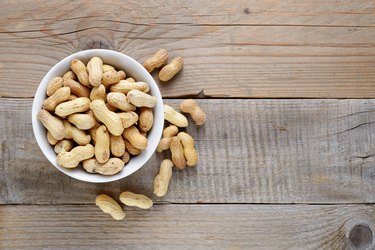
Americans eat more than 4 million pounds of peanuts per day, according to Purdue University. If you eat a lot of a particular food, you should choose the healthiest version to make it easier to stay within your diet and nutrition goals. When it comes to peanuts, this means opting for unsalted, dry-roasted peanuts over oil-roasted peanuts.
Tip
When it comes to the healthier choice, it's a bit of a toss up between dry-roasted and oil-roasted peanuts. Dry-roasted are lower in calories and fat and may be better for the calorie-counter. But oil-roasted contain less sodium, which is better for your heart.
Video of the Day
Calories, Carbs, Protein and Fat in Peanuts
An ounce of dry-roasted peanuts , which is equal to about 32 peanuts, contains:
Video of the Day
- 164 calories
- 14 grams of fat
- 1.9 grams of saturated fat
- 6 grams of carbohydrates
- 2.2 grams of fiber
- 7 grams of protein
Per ounce, oil-roasted peanuts have more calories, with:
- 168 calories
- 15 grams of fat
- 2.4 grams of saturated fat
- 4.3 grams of carbohydrates
- 2.6 grams of fiber
- 8 grams of protein
The higher calorie, fat and saturated fat content of oil-roasted peanuts, which could lead to an increased risk for obesity, high cholesterol and heart disease, makes dry-roasted peanuts a better choice, even though they have slightly less protein and fiber.
Read more: 9 Healthy Nuts That May Help You Live Longer
Sodium Content of Peanuts
If you opt for salted nuts, dry-roasted nuts tend to contain more sodium, with 190 milligrams, than oil-roasted nuts, with 90 milligrams. Since dry-roasted nuts contain less flavor-adding fat, manufacturers may feel a need to use more salt to add flavor to the nuts and make them more appealing to consumers.
Consuming too much sodium increases your risk for high blood pressure, heart disease and stroke, however. You can easily remedy this problem by choosing unsalted nuts, eliminating the sodium discrepancy between the two types of nuts.
Read more: The Effects of Overeating Nuts
Vitamins in Peanuts
Both types of peanuts provide 19 percent of the daily value for niacin, but dry-roasted peanuts provide slightly more folate and vitamin E than oil-roasted peanuts, with 10 percent of the DV for folate compared to 8 percent, and 11 percent of the DV for vitamin E compared to 9 percent.
You need folate for forming DNA, and vitamin E acts as an antioxidant to rid your body of harmful free radicals that could otherwise damage your cells.
Minerals in Peanuts
As with vitamins, the mineral content of the two types of peanuts is very similar. Dry-roasted peanuts provide slightly more manganese, with 29 percent of the DV compared to 26 percent, but oil-roasted peanuts are slightly higher in phosphorus, with 11 percent of the DV compared to 10 percent.
Both types of peanuts provide 12 percent of the DV for magnesium. Manganese is necessary for bone development and wound healing, phosphorus is essential for forming DNA and magnesium is important for controlling blood sugar and blood pressure levels.